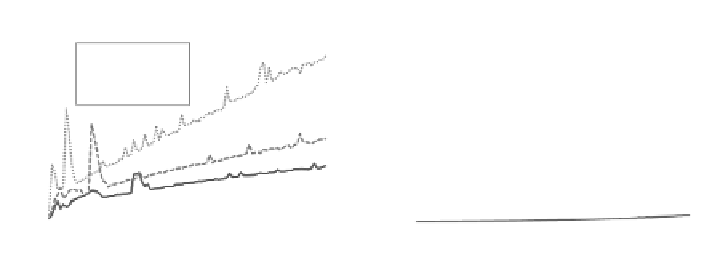Information Technology Reference
In-Depth Information
of components, each having varying number of properties but with constant number
of assumptions or guarantees (i.e., each component variable is therefore related to
only one expression). In the second part, each of the components has varying num-
ber of alternative and refined properties, so that many solutions are possible. In this
case, each component variable is related to many expressions.
The expressions in the first measurement are defined in a way that always the
intervals of the component variables have to be satisfied, and not the fixed values.
An example for such expression is given in Section 3.2 for the contract
C
II
,whichis
satisfied only if the variables
s
en
and
a
tr
are in ranges
[
0
,
6400
]
and
[
0
,
100
]
respec-
tively.
For the input test data, i.e. the operands of the assumption and guarantee expres-
sions, we generate the values for each expression randomly, but with the rule that
the assumptions are always satisfied. The advantage of performing the positive tests
here is to get more clear statement about the runtime of the verification. In both parts
of the measurement, we use the relational and logical operations on values.
In the second measurement, we execute the same system configurations as in
previous measurement, but this time using the fixed values for component variables.
4.1.2
Observations
First results of the experiments are illustrated in Figure 6. On the left, an excerpt of
the results for the first measurement is shown, where the properties have a constant
number of assumptions and guarantees. The reason why the verification responds in
70000
1600
1400
60000
#
alternat
ives per component
4
6
8
# compon
ents
10
20
50
1200
50000
1000
40000
800
30000
600
20000
400
10000
200
0
0
400
800 1200 1600 2000
# of assumptions/guarantees per component
0
200
20
400
40
600
60
800
80
1000
100
0
20
40
60
80
100
120
# of components
Fig. 6
Experimental results: runtime for system configuration with varying number of as-
sumption/guarantee expressions and components (left) and varying number of components
and alternative properties (right)
short time is that each component variable has only one expression (assumption or
guarantee constraint,
C
agc
), and it is then immediately instantiated to a value indi-
cated by that expression. The runtime depends in this case therefore on the number
of components and properties.
On the right in Figure 6, a scenario that is more likely to occur in practice is
shown. Here, each component variable has an increasing number of expressions,


























































Search WWH ::

Custom Search